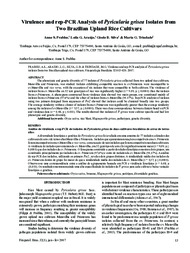Virulence and rep-PCR analysis of Pyricularia grisea isolates from two Brazilian upland rice cultivars.
Virulence and rep-PCR analysis of Pyricularia grisea isolates from two Brazilian upland rice cultivars.
Author(s): PRABHU, A. S.; ARAÚJO, L. G.; SILVA, G. B.; TRINDADE, M. G.
Summary: The phenotypic and genetic diversity of 77 isolates of Pyricularia grisea collected from two upland rice cultivars, Maravilha and Primavera, was studied. Isolates exhibiting compatible reaction to cv.Primavera were incompatible to cv.Maravilha and vice versa, with the exception of six isolates that were compatible to both cultivars. The virulence of isolates from cv. Maravilha on 32 test genotypes of rice was significantly higher (t = 9.09, p < 0.0001) than the isolates from cv.Primavera. A phenogram constructed from virulence data showed two main groups, one constituted mainly of isolates from cv.Primavera (97.6%) and the other of isolates from cv.Maravilha (91.17%). Rep-PCR analysis of isolates using two primers designed from sequences of Pot2 showed that isolates could be clustered broadly into two groups. The average similarity within a cluster of isolates from cv.Primavera was significantly greater than the average similarity among the isolates of cv.Maravilha (t = 5.37, p < 0.0001). There was close correspondence between clusters based on PCR and virulence data (r = 0.48, p < 0.011). The results showed that isolates of P. grisea were cultivar specific and had low phenotypic and genetic diversity.
Publication year: 2007
Types of publication: Journal article
Unit: Embrapa Rice & Beans
Keywords: Arroz, Brusone, Diversidade genética, Magnaporthe grisea, Oryza Sativa, Patótipo, rice
Observation
Some of Embrapa's publications are published as ePub files. To read them, use or download one of the following free software options to your computer or mobile device. Android: Google Play Books; IOS: iBooks; Windows and Linux: Calibre.
Access other publications
Access the Agricultural Research Database (BDPA) to consult Embrapa's full library collection and records.
Visit Embrapa Bookstore to purchase books and other publications sold by Embrapa.

